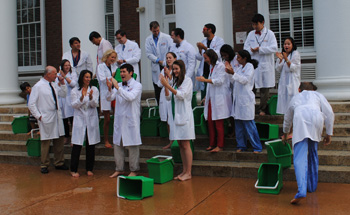My dad doesn’t know the difference between texting and tweeting. So when I told him I had just taken the ALS Ice Bucket Challenge, I expected I’d have to explain just what that was. Instead he said, “Oh, that’s really cool!”

That’s when I knew this thing was everywhere.
What is ALS?
As many as 30,000 Americans have ALS (also known as Lou Gehrig’s disease) right now, according to the ALS Association, but neurologist Ted Burns, MD, works with patients who didn’t know what ALS was until they were diagnosed with it.
“It’s a terrible disease,” he says.
Essentially, ALS causes the neurons that control muscle activity to degenerate and die, so they can no longer signal the muscles. The onset of muscle weakness can begin just about anywhere. Patients may initially develop weakness in the arms, legs and neck, and eventually they lose their ability to speak, swallow and breathe. Others first note trouble speaking, swallowing or breathing.
They may die within 3-5 years of developing symptoms, although Burns has patients who have had it for 20 years or longer. Why some people deteriorate faster than others is one of the many unknowns of ALS.
Where the Money Goes for ALS
There is no cure for ALS, and the one FDA-approved treatment, a drug called riluzole, only slows progression by a few months on average. Donations to the ALS Association fund clinical trials to find better treatments and a cure.
Researchers and doctors are also working to understand why some patients develop ALS when they have no clear genetic predisposition and what exactly ALS does to motor neurons and the cells around them.
“The money will be put to good use, but we need to keep raising money,” Burns says.
At UVA, researchers are looking at the quality of life of patients and collaborating with other ALS centers to share important clinical data to better understand the disease.
ALS Care in Charlottesville
UVA’s Richard R. Dart ALS Clinic offers physical, occupational and speech therapy, along with support from a team that also includes neurologists, nurse coordinators, social workers and nutritionists.
The clinic has about 90 patients, and Burns says the group of employees has been consistent over the last 10 to 15 years. “Very dedicated, experienced care providers,” he says.

Thanks for sharing this very good piece of information. Very interesting points too!